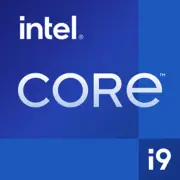Intel Core i9-7960X

Intel Core i9-7960X: In-depth Processor Analysis for Professionals in 2025
Updated: April 2025
Key Features: Architecture and Performance
The Intel Core i9-7960X processor, released in 2017, remains a niche solution for specific tasks. Its Skylake-X architecture (14 nm) features 16 cores and 32 threads thanks to Hyper-Threading. The base frequency is 2.8 GHz, with a boost option up to 4.2 GHz in turbo mode. The L3 cache size is 22 MB, which accelerates the processing of multithreaded tasks.
Key Highlights:
- Support for AVX-512 to accelerate computations in scientific and engineering applications.
- Turbo Boost Max 3.0 technology that automatically overclocks the most powerful cores.
- A quad-channel memory controller for using DDR4.
In the Geekbench 6 test (2025), the processor shows 1313 points in single-core and 9066 in multi-core modes. This demonstrates its strength in parallel tasks but reveals its weakness in modern gaming, where high IPC (instructions per clock) is crucial.
Compatible Motherboards: Socket and Chipsets
The i9-7960X uses the LGA 2066 socket, limiting the choice of motherboards to outdated Intel X299 chipsets. In 2025, new X299 boards are no longer produced, but they can be found from some suppliers or on the secondary market.
Popular Models (Price: $250–500):
- ASUS ROG Rampage VI Extreme — a top option with overclocking support and 5 PCIe 3.0 slots.
- MSI X299 Gaming Pro Carbon AC — a balance between price and functionality, including Wi-Fi 6 and RGB lighting.
Selection Features:
- Check for support for DDR4-2666+ (non-overclocked).
- Ensure the presence of a quality power delivery system (VRM) for stable operation of the 16-core CPU.
- Pay attention to the number of M.2 and SATA slots if planning to use NVMe drives.
Supported Memory: DDR4 and Its Limitations
The processor works only with DDR4 (max. 128 GB, frequency up to 2666 MHz without overclocking). In 2025, this is a significant drawback, as DDR5 has become the standard for new PCs, offering double the bandwidth.
Recommendations:
- Use quad-channel kits (e.g., 4x16 GB DDR4-3200) to unlock the potential.
- For memory overclocking, choose boards that support XMP profiles.
Power Supply: Power Calculation
With a TDP of 165 W and peak consumption up to 250 W (when overclocked), a reliable PSU is critically important.
Tips:
- At least 750 W for a system with one graphics card (e.g., NVIDIA RTX 4070 Ti).
- Choose models with 80+ Gold/Platinum certification (Corsair RM750x, Seasonic PRIME GX-850).
- Allow for power headroom for future upgrades.
Pros and Cons of i9-7960X in 2025
Pros:
- 16 cores/32 threads — ideal for rendering, virtualization, and video encoding.
- Relatively low price on the secondary market (~$300–400 compared to $1700 in 2017).
- Support for AVX-512 for specialized tasks.
Cons:
- 14 nm process — high power consumption and heat generation.
- Lacks support for PCIe 4.0/5.0 and DDR5.
- Weak performance in gaming due to low IPC compared to Ryzen 7000/Intel 13-14 Gen.
Use Cases: Who Is It Suitable For?
1. Professional Workstations:
- Rendering in Blender, Cinema 4D.
- Code compilation, virtualization (VMware, Hyper-V).
Example: Users report a 30% reduction in rendering time for 3D scenes compared to 8-core CPUs.
2. Multimedia:
- Video encoding in HandBrake or Adobe Premiere.
3. Gaming:
- Only suitable for older titles or paired with a powerful GPU at 4K resolution, where the load shifts to the graphics card. In modern games (e.g., Cyberpunk 2077: Phantom Liberty), FPS drops may occur due to the outdated architecture.
Comparison with Competitors
- AMD Ryzen 9 7950X (2024): 16 cores, 5.7 GHz, DDR5, PCIe 5.0. Better in gaming (+40% IPC) and energy efficiency (TDP 170 W at 5 nm), but more expensive ($550–600).
- Intel Core i9-14900K (2023): 24 cores (8P+16E), 6.0 GHz, DDR5. Performs better in single-threaded tasks but lags behind in multi-threaded against the 16 physical cores of i9-7960X.
Conclusion: The i9-7960X is relevant only as a budget solution for multithreaded tasks where price is more important than technological novelty.
Building Tips
1. Cooling: A custom liquid cooling solution is essential (e.g., NZXT Kraken X63) or a top-tier air cooler (Noctua NH-D15).
2. Case: Good ventilation (Lian Li Lancool III, Fractal Design Meshify 2).
3. Additions:
- A graphics card at the level of RTX 4070 or higher.
- NVMe SSD (Samsung 990 Pro) to minimize PCIe 3.0 bottlenecks.
Conclusion: Who Should Buy the i9-7960X in 2025?
This processor should be considered only for narrow tasks:
- Budget workstation for rendering.
- Upgrade of an old X299 system without changing the motherboard.
- Overclocking experiments.
For gaming, modern applications, and energy efficiency, it's better to choose Ryzen 7000 or Intel 13-14 generations. However, if you find the i9-7960X at a low price and can tolerate its shortcomings, it still has the potential to impress in multithreading tasks.
Basic
CPU Specifications
Memory Specifications
GPU Specifications
Miscellaneous
Benchmarks
Compared to Other CPU
Share in social media
Or Link To Us
<a href="https://cputronic.com/cpu/intel-core-i9-7960x" target="_blank">Intel Core i9-7960X</a>